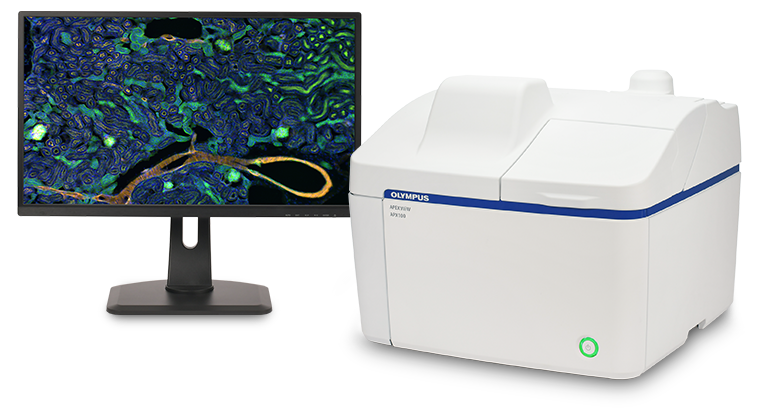Built with renowned Olympus optics, intuitive software, a powerful AI and a suite of smart features, the APX100 system combines the ease of use of an all-in-one microscope with publication-quality images to make life science research more efficient. Designed for labs and imaging core facilities, the microscope’s small footprint, built-in anti-vibration mechanism and light-shielded optics enable the system to be placed anywhere, even in a brightly lit room.

Image Credit: Evident Corporation
Research Images Made Simple
While conventional microscopes can require time-consuming adjustments to capture good images, the APX100 imaging system performs most of these adjustments automatically so that you can focus on your research.
Using the APX100 imaging system is simple—load the sample, close the lid and press a button. The system then automatically acquires an overview macro image while the built-in AI locates and displays the samples on the monitor, so the user can immediately begin capturing images. This process happens quickly thanks to the system’s improved autofocus. It is up to twelve times faster than conventional autofocus methods, enabling the user to quickly find the ideal imaging plane.
Publication-Quality Images in a Few Clicks
The APX100 imaging system uses the same optics found in Olympus’ high-end research microscopes, making it possible to acquire publication-quality images for a wide range of applications. Most objectives—including the award-winning X Line and silicone immersion objectives—are compatible with the system, providing the flexibility to acquire high-quality images for advanced research applications.
The system is also equipped with a new gradient contrast method, which makes it possible to capture sharp, high-contrast images of live cells or thin, unstained tissue sections without the need for specialized differential interference contrast or phase contrast optics. This method has many unique benefits; it is less affected by the meniscus, container lids and water droplets, and can be used on both glass- and plastic-bottom dishes and multi-well plates. It also enables you to image through the plastic lids of Petri dishes and multi-well plates, reducing the risk of contamination.
Fast, Efficient Data Management
To keep images organized, the APX100 system automatically organizes and stores your data. When an image is acquired, the software creates folders for each sample and saves the data into the correct one. All the important acquisition settings are saved with the images so that they can easily be recalled for future experiments.
See the APX100 System at Its Public Debut
- June 15–17—International Society for Stem Cell Research (booth # 629), Moscone West Convention Center, San Francisco, California, USA.
- June 21–24—Analytica (hall A2, booth # 629), Messe München, Munich, Germany.
- June 30–July 2—Japan Neuroscience Society, Okinawa Convention Center, Okinawa, Japan.
- August 13–17—Chinese Society for Cell Biology, Xiamen International Conference Center, Fujian, China.
To learn more about the APX100 digital imaging system, visit www.olympus-lifescience.com/en/solutions-based-systems/apx100/.
Source: https://www.olympus-lifescience.com/en/


